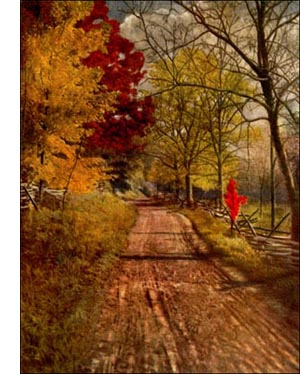Silver Maple or Soft Maple Tree
 Silver Maple, Soft Maple (Acer saccharinum, Linn.; Acer dasycarpum, Ehr.)-A large tree, 80 to 120 feet, with wide spreading top, trunk soon dividing into long limbs, ending in slender, drooping twigs. Bark reddish brown, furrowed, surface roughly scaly; twigs reddish, smooth. Wood hard, pale brown, close grained, brittle; easy to work. Sap sweet.
Silver Maple, Soft Maple (Acer saccharinum, Linn.; Acer dasycarpum, Ehr.)-A large tree, 80 to 120 feet, with wide spreading top, trunk soon dividing into long limbs, ending in slender, drooping twigs. Bark reddish brown, furrowed, surface roughly scaly; twigs reddish, smooth. Wood hard, pale brown, close grained, brittle; easy to work. Sap sweet. Winter buds: leaf buds pointed, red, in pairs; flower buds blunt, red, clustered at nodes. Leaves 4 to 7 inches long, deeply 5-cleft by narrow sinuses, irregularly toothed; smooth, pale green, white beneath, pubescent along veins; yellow in autumn; petioles long, red, flexible.
Flowers, March to April, before leaves, greenish yellow, without petals, on spurs or in axils of last year's leaves; fertile and sterile on different branches or often on separate trees.
Fruit, May, in pairs of winged samaras, 1 1/2 to 3 inches long, on short pedicels, pubescent and green when young, becoming smooth; germinating soon after they fall. Preferred habitat, rich, moist soil.
Distribution, Newfoundland to Dakota; south to Florida and Oklahoma. Rare on Atlantic seaboard and on mountains. Uses: Popular ornamental and shade tree, especially useful west of Mississippi River. Wood used for flooring and cheap furniture. Sap boiled occasionally for sugar.
The silver maple is a tree to count upon, if one is in search of a suitable species to plant on a Western prairie that has uncertain rainfall. It has ingratiated itself with people living farther east, who might better choose elms and other maples. It is a lazy man's tree, for it comes vigorously from seed, and bears transplanting, even when there are radical changes in soil and in climate to be met. it is a rapid grower, soon giving ample shade. But rapid growth implies brittle, weak wood, as a rule. Slowgrowing trees like elms should always be alternated with soft maples, to replace them after their brief race is run.
The habit of a tree must be considered when choosing a place to plant it. It is unwise to plant silver maples close to a house, as they have great horizontal spread, and the long, weak limbs are easily broken by ice and wind storms. Old trees are often cut back to a few main stubs above the trunk. A new top is soon formed by suckers that rise from the stubs, but the tree's symmetry is forever lost.
Local names often confuse the two Eastern early blooming, early fruiting maples. They may easily be distinguished by their mode of growth, flowers, fruits and leaves. Red maple limbs are small and rarely droop; those of the silver maple curve downward, but the twigs ascend. The brilliant colour belongs to the red maple; the deep-cleft, silver-lined leaves to the silver maple. 7 he little, smooth, long-stemmed keys of the red species differ distinctly from the large, short-stemmed fruits of the other, which are woolly until almost ripe. In winter even, buds and twigs of the red maple are vividly red.